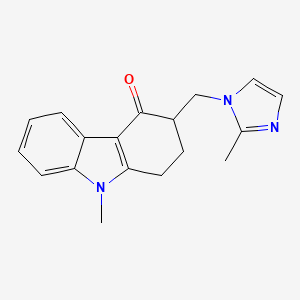Attribution Statement: LactMed is a registered trademark of the U.S. Department of Health and Human Services.
NCBI Bookshelf. A service of the National Library of Medicine, National Institutes of Health.
Drugs and Lactation Database (LactMed®) [Internet]. Bethesda (MD): National Institute of Child Health and Human Development; 2006-.
CASRN: 99614-02-5

Drug Levels and Effects
Summary of Use during Lactation
Ondansetron is frequently used for nausea during and after cesarean section, usually in doses of 4 to 8 mg intravenously.[1-4] Use during and after cesarean section appears to not affect the onset of breastfeeding.[1,5] No adverse infant effects have been reported in this setting or among women who received ondansetron postpartum in a pharmacokinetic study. Use of ondansetron in nursing mothers beyond the immediate postpartum setting has not been studied well, but the drug is labeled for use in infants as young as 1 month of age. A computer model demonstrated that the amounts in milk are much less than this dose. No special precautions are required.
Drug Levels
Maternal Levels. A computer model was built to simulate ondansetron levels in breastmilk. The model was validated and optimized using blood and milk levels from 78 women who had received ondansetron by intravenous injection therapeutically. The 78 women included in the analysis contributed a total of 67 plasma samples and 53 milk samples. After optimizing the model, the median peak milk concentration was predicted to be 20.2 mcg/L at 0.5 hours after a 4 mg intravenous dose at 2 days postpartum. The estimated daily infant dosage was 5 mcg/kg, which translated into a relative infant dose of 3.3% of the maternal weight-adjusted dosage and was 1.6% of the standard dosage given to infants.[6]
Infant Levels. Relevant published information was not found as of the revision date.
Effects in Breastfed Infants
In a pharmacokinetic study of 78 women who received ondansetron intravenously postpartum, no adverse effects were reported in their breastfed infants.[6]
Effects on Lactation and Breastmilk
A randomized, double-blind study compared placebo to intravenous ondansetron 4 mg given after cesarean section as prophylaxis for postoperative nausea and vomiting. There was no difference in the time of the first breastfeeding between the two groups.[3]
In a retrospective study of women undergoing cesarean section deliveries, 3 regimens were compared: dexmedetomidine before anesthesia and during delivery (n = 115), normal saline before anesthesia and during delivery and dexmedetomidine after delivery (n = 109), and normal saline before anesthesia and during delivery (n = 168). All women received ondansetron 4 mg as needed and before removal of sutures. The average total amount of ondansetron consumed in the women ranged from 6 mg to 9 mg in the various groups. The time to first production of milk was similar in all groups (25 to 28 minutes).[5]
References
- 1.
- Uerpairojkit K, Chesoh A, Budcharoentong D. Ondansetron for prophylaxis of spinal morphine induced nausea during early rooming in breastfeeding: A randomized placebo controlled trial. J Med Assoc Thai. 2017;100:1283–9. http://www
.jmatonline.com - 2.
- Suppa E, Valente A, Catarci S, et al. A study of low-dose S-ketamine infusion as "preventive" pain treatment for cesarean section with spinal anesthesia: Benefits and side effects. Minerva Anestesiol. 2012;78:774–81. [PubMed: 22374377]
- 3.
- Jelting Y, Klein C, Harlander T, et al. Preventing nausea and vomiting in women undergoing regional anesthesia for cesarean section: Challenges and solutions. Local Reg Anesth. 2017;10:83–90. [PMC free article: PMC5558589] [PubMed: 28860857]
- 4.
- Griffiths JD, Gyte GM, Paranjothy S, et al. Interventions for preventing nausea and vomiting in women undergoing regional anaesthesia for caesarean section. Cochrane Database Syst Rev. 2012;2012:CD007579. [PMC free article: PMC4204618] [PubMed: 22972112]
- 5.
- Zhao W, Ma L, Wang J, et al. Retrospective comparison of the safety and effectiveness of dexmedetomidine versus standard of care before and during cesarean delivery in a maternity unit in Zhengzhou, China. Med Sci Monit. 2020;26:e925709. [PMC free article: PMC7592428] [PubMed: 33097682]
- 6.
- Job KM, Dallmann A, Parry S, et al. Development of a generic physiologically based pharmacokinetic model for lactation and prediction of maternal and infant exposure to ondansetron via breast milk. Clin Pharmacol Ther. 2022;111:1111–20. [PMC free article: PMC10267851] [PubMed: 35076931]
Substance Identification
Substance Name
Ondansetron
CAS Registry Number
99614-02-5
Drug Class
Breast Feeding
Lactation
Milk, Human
Antiemetics
Gastrointestinal Agents
Serotonin Antagonists
Serotonin 5-HT3 Receptor Antagonists
Disclaimer: Information presented in this database is not meant as a substitute for professional judgment. You should consult your healthcare provider for breastfeeding advice related to your particular situation. The U.S. government does not warrant or assume any liability or responsibility for the accuracy or completeness of the information on this Site.
- User and Medical Advice Disclaimer
- Drugs and Lactation Database (LactMed) - Record Format
- LactMed - Database Creation and Peer Review Process
- Fact Sheet. Drugs and Lactation Database (LactMed)
- Drugs and Lactation Database (LactMed) - Glossary
- LactMed Selected References
- Drugs and Lactation Database (LactMed) - About Dietary Supplements
- Breastfeeding Links
- PMCPubMed Central citations
- PubChem SubstanceRelated PubChem Substances
- PubMedLinks to PubMed
- Ondansetron - Drugs and Lactation Database (LactMed®)Ondansetron - Drugs and Lactation Database (LactMed®)
Your browsing activity is empty.
Activity recording is turned off.
See more...
